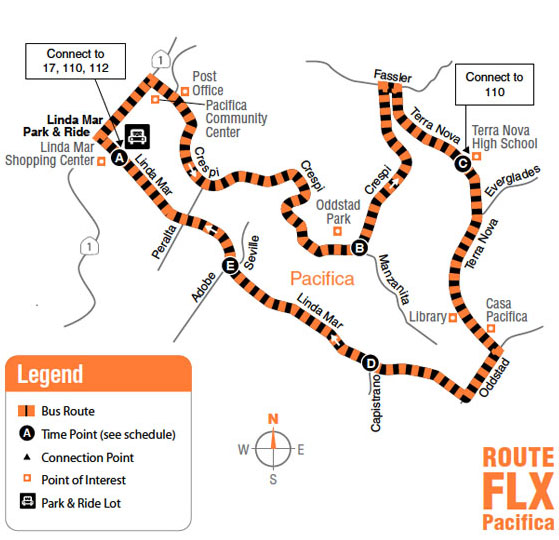At the February 5 SamTrans Board meeting the results of the Linda Mar On Demand transit pilot were presented. On March 16 COVID-19 shelter-in-place was ordered for the Bay Area counties. SamTrans response to shelter-in-place orders:
- Non baseline (e.g., driver, maintenance, etc.) employees work remotely
- Bus farebox collection suspended to June or later
- Instituted bus passenger rear door only boarding
- Posted social distancing and mask requirement signage on buses
- Installed chain between bus driver and passengers to protect drivers
- Service level adjustments: (a) Eliminated school service, (b) reduced service to modified Saturday services consistent with demand
- Prepared ready reserve buses to comply with social distancing requirements when/where passenger demand increases
- Mid-May, started taking employee temperatures and provided voluntary employee COVID-19 testing
After March 16, ridership was down 80%. With the early May slight relaxing of shelter-in-place orders ridership rose slightly. Most of SamTrans funding comes from sales tax and not from the farebox, which allows them to continue to operate. SamTrans has applied for and will receive $28M from the CARES act.
On May 6, 2019 SamTrans replaced the existing Linda Mar FLX fixed route bus service by launching a one year microtransit ‘OnDemand’ service in order to understand the customer experience and learn what it takes for SamTrans to support and scale a microtransit service.
- The OnDemand service offered point-to-point shuttle service within the Linda Mar coverage area for the standard SamTrans fare. Trips were booked via a smartphone app or through the SamTrans Customer Service Call Center.
On May 4, 2020 SamTrans ended the ‘OnDemand’ pilot and re-established the FLX service.
The SamTrans Project Managers, Christy Wegener and Daniel Shockley, presented results of the one year OnDemand pilot experiment in February at the SamTrans Board meeting and at the Pacifica regular City Council meeting. 63% of riders surveyed preferred OnDemand to FLX; however, the average daily riders using OnDemand was 13% lower than FLX.
The OnDemand service, supporting Linda Mar passengers, included:
(1) One 18-seat bus, 25-passenger capacity including standing
(2) New Technology partner ‘Via Transportation’
- Passenger On Demand smartphone app – to request a ride on demand. 70% of the participants who downloaded the App signed up and 50% used the service.
- Driver app to track ridership and report route deviations (e.g.,
- Parameter-driven algorithm to compute wait times, routes, schedules, etc. Average wait time after requesting a ride was 12 minutes.
(3) Enhanced Customer Service Call Center for passengers without smartphones to request an on demand ride. 30% of the rides were made via the Call Center
(4) Communication and outreach programs
- Ensure FLX riders had support when OnDemand was initially launched
- Advertising and support to Linda Mar residents throughout the year to sign-up and use the ‘Via’ App
- Multiple rider, bus driver and call center operator interviews and surveys
- Outreach to Linda Mar community and schools for converting back to FLX

Findings
- Most complaints attributable to trip denial after request (Supply Message) – occurs when the software predicts (algo. adjustment) that the rider will not be able to get to their destination in under 30 minutes, in which case, the app will tell the rider “no seats are available”.
- Microtransit may not be the right solution for large groups travelling at the same time. Terra Nova High students let out mid-day twice a month making ride requests at the same time, flooding the system, causing complications and confusion. Better to have a predictable fixed route bus that students just wait for and board (note: Marin Connect with 4 microtransit vehicles had the same problem when Terra Linda High let out).
- Unanticipated accommodation for skewing of service availability due to mandatory driver 30-minute daily break.
SamTrans Project Manager Recommendation’s for deploying microtransit service
- Use more than one vehicle, perhaps expand to multiple service areas (note: Sacramento has 42 microtransit service areas)
- Do not replace an existing service, instead complement existing services
- Heavy use of call center would require expansion/enhancement of call center capability
SamTrans Next Steps
- Completed conversion back to Pacifica FLX service
- Apply Pacific OnDemand Pilot learnings to the SamTrans Reimagine Program

Post Pandemic
There is much speculation about the effect on transit as we emerge from shelter-in-place, but it will be a learning-as-we go experiment. The Institute for Transportation & Development Policy has reported the following on Chinese transport network reopening:
“… cycling has grown dramatically; Uber, Didi and other Transit Network Companies (TNCs) are down, and more people are opting for buses over the metro..”